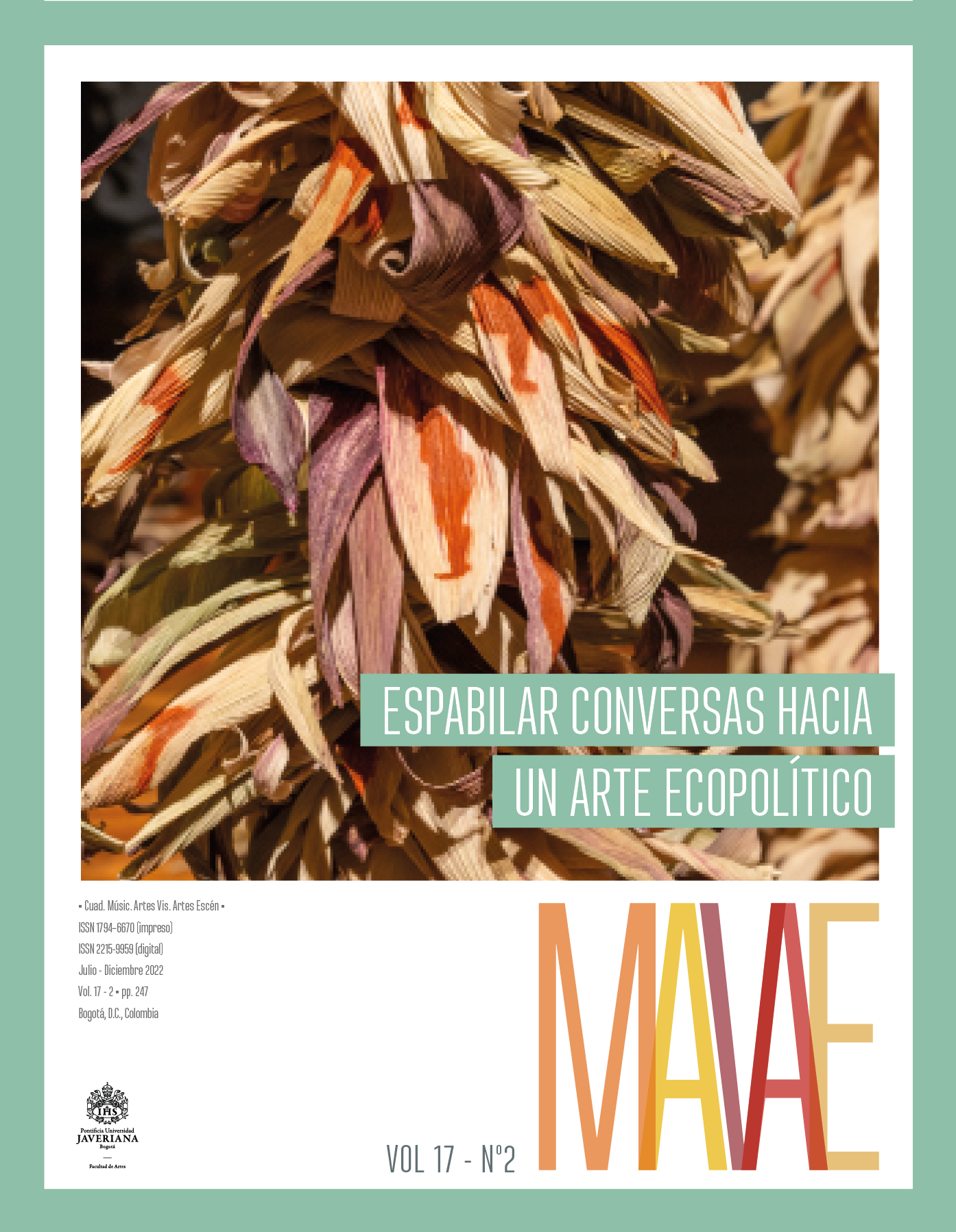Abstract
This paper aims to offer the keys to read and interpret the 1:1 scale map of tactile relationships, an artistic practice developed between Eulalia de Valdenebro Cajiao and a frailejón plant (Espeletia grandiflora). To that end, its elaboration method and the geometric order that structures it are described in three types of statements: simple propositions, axioms of proportion, and poetic theorems. Over the course of these descriptions, the poetic and critical value of the artistic practice understood as a longterm graphic performance is revealed. The 1:1 scale map of tactile relationships is part of a broader research on the art-science relationship in the modern botanical episteme, where this way of knowing the plant world is identified as one of the key elements that makes up our current climate situation, well expressed by Isabelle Stengers as “the intrusion of Gaia.” In the artistic practice of elaborating the 1:1 scale map of tactile relationships, there is an appropriation of the methods of the critically reconfigured modern botanical episteme. In it, key elements of modernity are questioned, such as the hierarchy established between subject-scientist object-plant, universal measurements, the notion of species and the value of truth or objectivity of the scientific method. On the other hand, the geometric method used proposes to re-visit a spinosite modernity that gives important hints for the critique of hegemonic modernity.
Chirolla Ospina, Gustavo. 2021. Estética y política de la naturaleza a la luz del neoespinosismo. Bogotá: Pontificia Universidad Javeriana.
Cvrčková, Fatima, Helena Lipavská y Viktor Žárskỳ. 2009. “Plant Intelligence: Why, Why Not or Where?”. Plant Signaling & Behavior 4, n.º 5: 394-
https://doi.org/10.4161/psb.4.5.8276.
Danowski, Déborah y Eduardo Viveiros de Castro. 2019. ¿Hay mundo por venir? Ensayo sobre los miedos y los fines. Buenos Aires: Caja Negra.
Deleuze, Gilles y Félix Guattari. 1998. Mil mesetas: Capitalismo y esquizofrenia. Traducido por José Vázquez Pérez. Valencia: Pre-textos.
Diazgranados, Mauricio. 2013. “Aportes a la delimitación de los páramos desde el estudio de los frailejones”. En Visión socioecosistémica de los páramos y alta montaña colombiana: Memorias del proceso de definición de criterios para la delimitación de páramos, editado por Jimena Cortés-Duque y Carlos Enrique Sarmiento-Pinzón, 23- 37. Bogotá: Instituto Humboldt. http://www.humboldt.org.co/es/component/k2/item/409-vision-socioecositemica-de-los-paramos-yla-alta-montana-colombiana-memorias-del-proceso-de-definicion-decriterios-para-la-delimitacion-de-paramos.
Didi-Huberman, Georges. 2008. Ser cráneo: Lugar, contacto, pensamiento, escultura. Traducido por Gustavo Zalamea. Bogotá: Universidad
Nacional de Colombia.
Emanuele, Coccia. 2016. La vie des plantes: Une métaphysique du mélange. París: Payot & Rivage.
Hiernaux, Quentin. 2021. Philosophie du végétal. París: Vrin.
Latour, Bruno. 2019. Cara a cara con el planeta: Una nueva mirada sobre el cambio climático alejada de las posiciones apocalípticas. Buenos
Aires: Siglo XXI.
Lozano Rocha, Ana María. 2020. “Un dibujante + una mujer que posa + una pantalla + una cuadrícula o dos cortes en la sustancia del mundo”.
Cuadernos de Música, Artes Visuales y Artes Escénicas 15, n.º 1, 158-171. https://doi.org/10.11144/javeriana.mavae15-1.udum
Margulis, Lynn. 2002. Planeta simbiótico: Un nuevo punto de vista sobre la evolución. Barcelona: Debate.
Margulis, Lynn y Dorion Sagan. 2013. Microcosmos: Cuatro mil millones de años de evolución desde nuestros ancestros microbianos. Traducido
por Mercè Piqueras. Barcelona: Tusquets.
Margulis, Lynn y Oona West. 2003. “Gaia y la colonización de Marte”. En Una revolución en la evolución, editado por Juli Peretó, 225-238.València: Universitat de València.
Næss, Arne. 2017. Une écosophie pour la vie: Introduction à l’écologie profonde. París: Éditions du Seuil.
Stengers, Isabelle. 2017. En tiempos de catástrofe: Cómo resistir a la barbarie que viene. Barcelona: Ned.

This work is licensed under a Creative Commons Attribution 4.0 International License.


